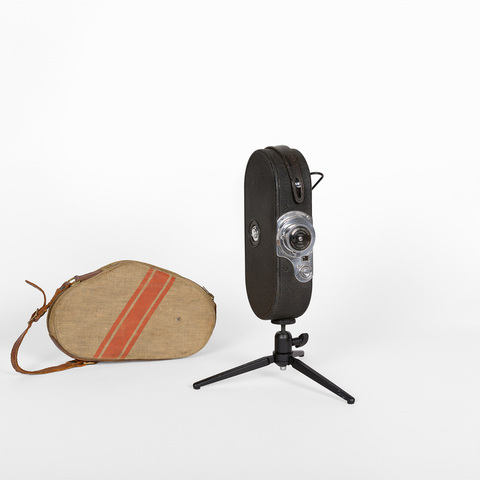Caméra film 16 mm
Fiche détaillée
Type de l'appareil
entraînement du film 16 mm par deux griffes ; un débiteur denté ; emplacement intérieur pour deux bobines de 30 m. ; moteur à ressort ; couloir presseur ; diaphragmes rotatifs 3.5, 5.6, 6.3, 8 et 11 ; intérieur en acier bouchonné ; schéma d'explication collé au revers du couvercle ; viseur ; quatre vitesses ("low", "normal", "slow motion", "talking picture speed" ; compteur de pieds ; lanière en cuir ; sac de transport en toile
Auteurs
Informations non disponibles
Fabricants
Stewart Warner
Chicago, Illinois
Utilisateurs
Informations non disponibles
Distributeurs
Stewart Warner
Chicago, Illinois
Sujet du modèle
Informations non disponibles
Objectif
Stewart Warner 1 : 3,5
Taille de l'objet
Ouvert :
Informations non disponibles
Fermé :
Longueur : 13.5 cm
Largeur : 6 cm
Hauteur : 23 cm
Diamètre :
Informations non disponibles
Taille de la boîte de transport
Informations non disponibles
Remarques
Marque : "Stewart Warner Hollywood Model Camera Chicago Ill. Made in USA". A l'intérieur : "Serial n° 25 477 model 531 B".
"The name Stewart-Warner is very well known in the motoring world, this company's speedometers being standard equipment on a very high proportion of American and other cars. With such precision equipment available it is not surprising that this company should turn its attention to cinematograph apparatus, and we are very interested to receive for test the Stewart-Warner 16 mm camera. The camera, which is fitted with a 3,5 anastigmat lens, will take either 50 or 100 ft. spools, and is equipped with four speeds - "low" (8 frames per second) - "normal" (16 frames per second) ; "talking picture" (25 frames per second) ; and "slow motion" (64 frames per second). A direct vision viewfinder is built into the casing in a convenient position and, of course, a footage indicator is provided. The winding handle is of the non-detachable variety and does not rotate during action when folded flat. Many ingenious features are incorporated in this camera to reduce cost of manufacture without reducing efficiency. For example, instead of an iris diaphragm to control the lens aperture, a circular plate bearing five different sizes of stop is made to rotate in front of the lens, the apertures being respectively 3.5, 5.6, 6.3 and 11, these also being marked "dull", "cloudy", "clear", "bright" and "distance". The release button is situated on an aluminium plate beneath the lens and can be clearly seen in the picture. The footage indicator operates by means of a thin lever which bears on the outside of the feed reel, the full reel pushing the lever out its utmost, while as the size of the reel is reduced so the change in footage is correspondingly indicated. [...] The test film taken with this instrument at the four different speeds show that the lens definition is good and the apparatus works satisfactorily. The price of £ 9.9s. complete in case with zip fastener, is remarkably low and represents excellent value, particularly when it is remembered that it is imported from America. Its has been submitted to us by Mr. Edwin Gorse, 86 Accrington Road, Blackburn" (Home Movies & Home Talkies, octobre 1933, p. 184).
Une version 8 mm est également proposée.
Bibliographie
Home Movies & Home Talkies, octobre 1933, p. 184.
Ariel Cinematographica Register, n° 254.
